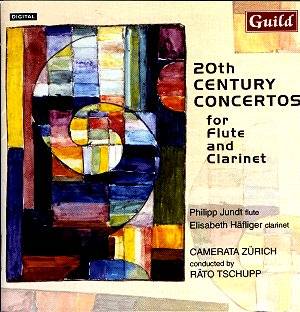I must admit that these four Swiss/German composers
were completely new to me. Listening to their music potentially necessitates
a dip into four contrasting and probably challenging sound-worlds. I
wasn’t expecting to find that they would be very similar to each other
although as one comes to read the biographies this becomes less of a
surprise.
I wasn’t too surprised to find that Hans Haller had
at one time been a pupil of Hindemith. The three movements of his double
concerto have certain traits such as neo-classical melodic turns in
cadences, which seem to typify the style. In the concerto there is much
attractive interplay between the soloists and much polyphonic writing
in general, the strings contributing jagged counterpoint of their own
between phrases. The first movement is the most substantial in length
but the Adagio second movement has an overwhelming sense of tragedy
in weaving, sinewy lines. The Finale beginning with trills from the
soloists seems no more than mere note-spinning as indeed I feel can
Hindemith.
Wladimir Vogel’s Concertino is in one movement but
two sections, Tempo libero and Lento quieto. He was born in Moscow but
to a German father, living in Berlin and later in Switzerland, studying
for a time with Busoni. I felt the influence here on Vogel of Busoni’s
eccentric, chromatic and wide melodic lines as in his Concertino for
flute and orchestra of 1920. But also I felt that Vogel’s ideas tended
towards the short-winded and had little to make them memorable.
The CD is a co-production between "the Camerata
Zurich, the Hans Schaeuble Foundation and the Zentralbibliothek Zurich".
Not surprisingly Schaeuble’s piece takes an important position at the
end of the CD. I wish that I could report that I find this five movement
work individual. Although it is not unattractive or uninteresting it
fails to make its mark or its presence felt or to have a distinctive
profile. Its chromatic lines weave and fight with little change of colour.
The movements are nicely inter-linked and the third, a moderato, with
its jagged dotted rhythms is vaguely neo-classical. In the Intermezzo
fourth movement, a solo violin weaves its lines with the flautist and
the language is being unlike that found in the concertos of Berthold
Goldschmidt.
Robert Blum was born in Zurich and was a fellow student
of Kurt Weill. His single movement Concertino begins in dramatic manner
with a low string motif and a quizzical clarinet answer. Soon after,
an uncertain pizzicato passage begins over which the clarinet adds scalic
melodies and trills. Then there follows a passage in harmonics and later
a curious passage using quartertones. I was not surprised to read that
Blum has written much film music. The work is only twelve minutes in
duration and is full of arresting ideas but again nothing about it is
in any way individual. It fits into the profile of the CD as a whole
so that one cannot easily tell one composer from another.
Full marks for enterprise to the Jersey based company
Guild, and to the conductor the late Räto Tschupp who died just
a few works after making this disc, as did Hermann Haller. Tschupp obtains
wonderful precision out of the string players and gets from the scores
everything that he can to bring them alive. This CD therefore makes
a fitting tribute to a fine conductor and an outstanding musician who
is much missed.
Recordings are in quiet passages a little recessed
and so you may need to turn the volume up higher than usual. The booklet
notes with photographs are quite adequate but bearing in mind the unique
nature of this music a little more detail would have been useful.
Gary Higginson
